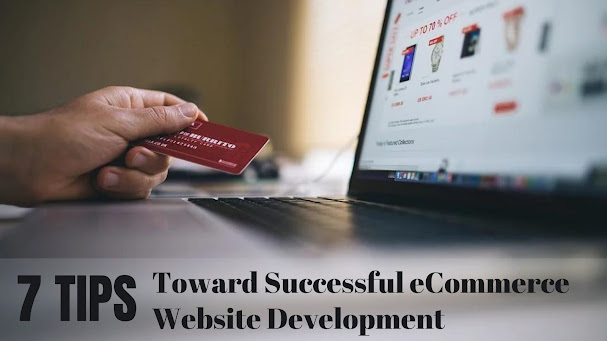7 Secret Tips For User Engaging eCommerce Website Development
An eCommerce website is much like a shop in a mall wherein first impressions are crucial. Customers can be drawn in through an attractive window show, and well-prepared merchandise will inspire them to browse and purchase. Cluttered and disorganized shops will discourage clients from getting into and could lose sales. To try this you first want to begin eCommerce website development.
An eCommerce website differs from different styles of websites. SSL configuration, fee alternatives, web website online architecture, design, web page load velocity, and images are only a few of the optionally available capabilities to remember. You'll want a platform that can take care of a massive quantity of server resources. Otherwise, your keep might also additionally enjoy a full-size slowdown or maybe crash. Check out this aid to study greater approximately how hiring the great eCommerce net improvement offerings can supply your company a competitive advantage.
Why Do You Need To Improve a Website if You Already Have One?
Strengthening the structure, web design, programming, publishing, and database management are all part of the eCommerce website development process. If your current website isn't performing well, doesn't look professional, or isn't visually appealing, it's time for a website redesign.
Whether you're thinking about building or redeveloping your eCommerce website, Here are 7 things to keep in mind to ensure its success.
1. Have Right Platform and Appropriate Functional Theme
Your company's foundation is its platform. When considering eCommerce website development, go with a tried-and-true platform like BigCommerce, Magento, Shopify, or another that can handle the volume you expect in the future. This is where your website's visitors will interact, it needs to be functional as well as visually appealing. After you've decided on a platform, the next critical decision is deciding on a theme.
Things To Keep In Mind When Finalizing Functionality & Theme:
Is visually appealing
Customizable to your brand
Loads quickly
Responsive
Works on all browsers
2. Search Engine Marketing And Site Performance
PageRank is still important in terms of traffic. Use proper eCommerce SEO and search marketing to ensure that your pages rank higher and that customers can find you. It's worth the effort because the CTR drops by more than half when you move from first to second place in the search results.
Site performance and page load speed have an impact on both UX and Google ranking. Impatient customers quickly abandon slow-loading websites. According to one survey, 40% of shoppers abandon a website if it takes more than 3 seconds to load. The bottom line is that faster loading pages result in a better user experience, which is beneficial to everyone.
3. Responsive Website Design For Any Mobile Device
Although it appears to be a no-brainer to have every web page optimized for mobile, thousands of merchants are still stuck with old themes and websites that only display properly on a desktop. Mobile users must be able to search, browse, and buy without difficulty from their phones and other devices.
4. Security For Trust And Safety Of Data
It takes time to build trust between a customer and a merchant, but it is critical for sales. One immediate improvement that fosters trust is to encrypt all pages, not just payment information pages, using the HTTPS protocol. Customers have the right to expect you to protect their personal information. Your website must be PCI (Payment Card Industry) compliant if you accept credit cards.
Payment information and transactions necessitate a high level of security. If you accept credit cards, your website must be PCI (Payment Card Industry) compliant. Don't store sensitive information, such as credit card numbers, on your company's website for added security. If your system is hacked, you are held accountable.
5. Limited Product Selection and Offering Site Search Option
Giving your customers too many options can hurt your sales. When buyers are confronted with an abundance of options, they experience decision paralysis. Rather than making any decision, they will leave your website.
Don't use the default search engine found on most websites. Purchase a powerful third-party search engine and provide shoppers with as many filters as possible to help them narrow their search as quickly as possible. To allow the search engine to find the products faster, you'll need detailed product descriptions that include targeted keywords.
6. Use Of Quality Pictures and Videos on Each Product
You must get right to the point, capture their attention, and keep them on the page until you can explain further because believe it or not, 10 seconds is about all the time you get to attract the customer to keep them on your website.
Photos are a great way to get people's attention, and video is a great way to keep it. The key to success is to have one or both of these elements above the fold on every page.
7. Smooth and Painless Transaction
The site search, great product descriptions, and photos helped the customer find what they were looking for. They have placed the item in their shopping cart and are ready to make the final payment but then face some issues like; unexpected shipping costs, no clear return policy, certain payments not accepted, they must create an account to complete the purchase, and more.
You've just deflated their shopping experience, and they may even abandon the cart. What could be done in order to prevent all this from happening?
The first step is to face the shipping policy. Post your shipping policies and fees on the home page and product pages. It avoids any unpleasant surprises. If your platform limits payment methods, it's time to switch to one that doesn't. You should be able to accept international credit and debit cards, as well as online payment gateways such as PayPal and Stripe, as well as digital wallets such as Apple Pay and Amazon Pay.
Conclusion:
All of the time and effort you put into developing your eCommerce site using these 7 tips serves a single purpose. To provide an excellent "UI" of the website as well as an excellent "UX" of shopping with you.
Any merchant's goal is to create a frictionless shopping system. Always test your systems by going through the purchasing process as if you were a customer. Look for ways to reduce bottlenecks and improve your overall user experience, and consider hiring an eCommerce app development company to help you with this.




Comments
Post a Comment